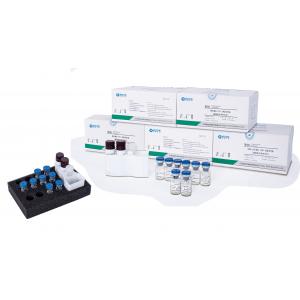

Add to Cart
CLIA Reagents of Inflammation (BNP)
【Expected usage】
Brain natriuretic peptide detection kit (magnetic particle
chemiluminescence method) (hereinafter referred to as this kit) is
used to quantitatively detect the content of brain natriuretic
peptide in human plasma in vitro.
Heart failure is an important clinical syndrome, mainly manifested
as left ventricular systolic or diastolic dysfunction, or both
systolic and diastolic dysfunction. Heart failure occurs when the
heart cannot pump blood at a certain rate to meet the needs of
tissue metabolism. The most common causes are coronary heart
disease, hypertension, heart valve disease and cardiomyopathy.
Accurate and early diagnosis of heart failure allows timely and
effective therapeutic interventions (eg, angiotensin-converting
enzyme inhibitors, beta-blockers), thereby improving heart failure
morbidity and mortality. According to the New York Heart
Association classification (NYHA classification I–IV), according to
clinical signs and symptoms, heart failure can be divided into 4
grades, and the severity of the disease increases gradually.
The natriuretic peptide system is a large class of peptides that
are structurally similar but genetically distinct. It includes
atrial natriuretic peptide (ANP) and cardiomyocyte-derived B-type
natriuretic peptide and endothelial cell-derived C-type natriuretic
peptide. The common feature of these polypeptides is a 17-amino
acid cyclic structure formed by connecting two cysteine residues
with one disulfide bond. Cardiac natriuretic peptide is a natural
antagonist of the renin-angiotensin-aldosterone system and the
sympathetic nervous system. They promote natriuresis and diuresis,
have vasodilatory effects, and exert anti-mitotic effects in
cardiovascular tissue. The heart secretes and releases ANP and BNP
in response to changes in hemodynamic pressure.
In the human body, B-type natriuretic peptide is mainly produced by
the heart and is released as the pressure on the heart increases.
Many studies have shown that an increase in B-type natriuretic
peptide is found in the circulating blood of patients with early
congestive heart failure. With the continuous aggravation of
congestive heart failure, the content of B-type natriuretic peptide
in the blood also increased. BNP testing provides an objective,
non-invasive method for the assessment of patients with heart
failure and risk stratification of acute coronary syndromes.
At present, the clinical methods for detecting the content of brain
natriuretic peptides include radioimmunoassay, enzyme-linked
immunosorbent assay, colloidal gold method, immunoturbidimetric
method and chemiluminescence immunodiagnosis method.
【Inspection Principle】
This kit adopts the principle of direct sandwich method, uses
magnetic microparticles as the solid phase of the immune reaction,
and uses chemiluminescence enzyme-linked immunoassay method and
chemiluminescence measuring instrument to determine the content of
brain natriuretic peptide in human plasma.
The technical principle is: Fluorescein isothiocyanate
(FITC)-labeled mouse monoclonal anti-BNP antibody combines with
alkaline phosphatase (AP)-labeled BNP paired antibody and BNP in
samples, calibrators or quality controls to form "" Sandwich"
complex. Then, the magnetic particles linked with the anti-FITC
antibody are added, and the antigen-antibody immune complex is
bound to the magnetic particles through the specific binding of the
anti-FITC antibody and FITC.
Under the action of an external magnetic field, the complex formed by the immune reaction is separated from other unbound substances, and after washing the complex, an enzymatic chemiluminescence substrate is added. The substrate is catalytically cleaved under the action of the enzyme to form an unstable excited state intermediate.
When the excited state intermediate returns to the ground state, photons are emitted to form a luminescence reaction, and the luminescence intensity of the reaction can be detected by a chemiluminescence instrument. In the range of detection wavelength (230-700nm), the luminescence intensity is proportional to the content of BNP in the sample, and the BNP concentration in the sample can be calculated by fitting the modified four-parameter Logistic equation.
| Test Item | BNP |
| Luminescent Principle | Enzymatic chemiluminescence |
| Luminescent Markers | AP(alkaline phosphatase) |
| Specification | 100 Test/Kit for CIA series |
| / | |
| Principle | Sandwich method |
| Component | Magnetic Beads |
| Calibrator Low | |
| Calibrator High | |
| Anti-A/Anti-B | |
| Control 1 | |
| Control 2 | |
| Accessories Required But Not Provided | Substrate |
| Washing solution | |
| Sample material | Serum |
| Storage | 2-8℃ |
